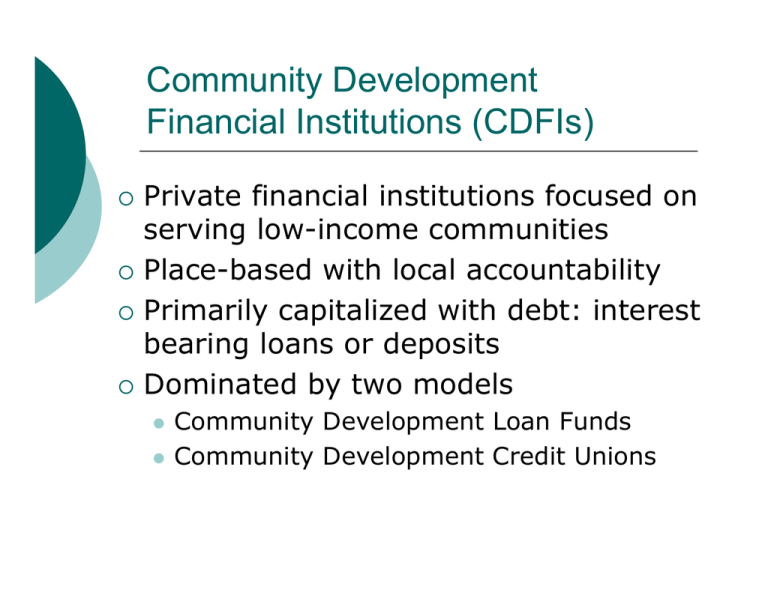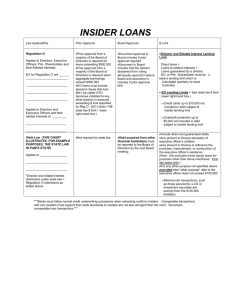Community Development Financial Institutions (CDFIs)
advertisement

Community Development
Financial Institutions (CDFIs)
{
{
{
{
Private financial institutions focused on
serving low-income communities
Place-based with local accountability
Primarily capitalized with debt: interest
bearing loans or deposits
Dominated by two models
z
z
Community Development Loan Funds
Community Development Credit Unions
Community Development Loan
Funds (CDLFs)
{
{
{
{
{
{
{
{
New model using capital from "social investors" to
raise funds for community development lending.
Several hundred exist nationally; about half have
an economic development mission.
Locally organized and controlled non-profit
organizations
Large share of capital (50 to 60%) from loans by
individuals, churches, foundations and banks.
Access to a larger and more diverse capital allows
larger average size than RLFs: almost $10 million
Risk profile is between that of banks and RLFs
Spread between cost of funds and lending rates
covers operating costs.
Need more assets to fund operating costs vs.
grant-based RLFs –average size close to $10 mm
CDLF Advantages
{
{
{
{
Relatively simple to start-up since no bank
charter needed
Community control and responsiveness
Flexibility in lending policies: no regulatory
constraints
Access to more funding than RLFs:
z
z
{
{
foundation and government grants
Institutional and individual loans
Capacity to lend a large share of assets (7090% vs. 50 to 60% for banks)
Source of below-market debt for housing or
non-profits by attracting below-market loans
and subsidies
Financing Roles Suited to CDLFs
{
Loan products must fit reliance on debt
z
{
{
{
{
{
Interest rates, amortization and loss must meet
cash flow obligations to investors
Short to medium term debt with moderate risk
Predevelopment financing for real estate
projects
Construction and bridge financing for affordable
housing, commercial real estate projects, and
non-profit facilities
Working capital and equipment financing for
small businesses
Working capital and equipment financing for
non-profit organizations
Business vs. Housing Oriented
CDLFs
{
{
{
{
Housing CDLFs are 2X larger and utilize
more debt capital than business funds
Business CDLFs make more loans, smaller
and have higher loss rates (7.2% vs. 2%)
than housing lenders
Business funds rely more on government
funding (46% vs. 5%)
Medium size business CDLFs ($2.5 to $8
mm) are strong performers with loss rates
and high self-sufficiency
CDLF Challenges & Best Practices
{
Defining target markets and products to match
community needs, repay debt and reach scale
z
{
Manage lending process to reduce loan losses
z
z
z
{
Sound underwriting standards and due diligence process
Expand technical assistance (Cascadia Loan Fund)
Fund expanded loss reserve
Cultivate a stable and large investor base
z
z
{
Trend toward serving expanded markets
geographically and by customer
Core set of lenders with low turnover of loans
Outreach and cultivation to expand investors: Boston
Community Capital has over 300 sources
Financial management of assets and liabilities
Community Development Credit
Unions
{
{
{
{
{
{
A membership organization supplying banking
services and loans to members with a common
affiliation (“field of membership”)
A financial cooperative--a member controlled
institution based on one member-one vote
governance
An insured depository institution
Serves low income individuals and communities
964 NCUA-designated credit unions with lowincome memberships; total assets of $15 billion
(2003)
Credit union model adapted to serve low-income
communities via the civil rights movement and
war on poverty
CDCU Characteristics
{
{
{
{
{
Provide banking, credit and development
services (e.g. education, counseling,
technical assistance)
NCUA Definition: 50%+ of members have
income below 80% of US median income or
earn 80% of national average wage
Average asset size of $16 million; 65% of
assets in loans. ROA on .9%
Lending focuses on consumer loans. Auto
loans account for 43% of loan assets; home
mortgages are 20%. Business loans capped
at 12.5% of loan portfolio, which can be
waived for LICUs.
Average loan charge-offs of .71% in 2003
Development Roles of CDCUs:
Banking Services to the Poor
{
{
Provide an alternative to predatory and highcost financial service firms
Tailor services to unique needs of non-banked
consumers
z
z
z
{
Convenient bundling of services
Wire transfers and affordable pay day loans
Partnerships to expand services and attract more
members
Financial literacy and asset development
z
z
z
Financial education and counseling
Credit building products and loans for low-income
needs
Individual development accounts to promote savings
Development Roles of CDCUs:
Small Business Lending
{
{
CDCUs are more active small business
lenders than conventional CUs
Potential CDCU business credit roles:
z
z
z
{
Personal loans for business purposes
Small business loans to independent businesses
with more emphasis on character lending
Specialized/niche business markets
{ Alternative business types
{ Minority or immigrant-owned enterprises
Affiliate entity to supply high-risk debt,
conduct training & technical assistance,
develop new products & services
CDCU Challenges and Best
Practice
{
Building a large membership to start and sustain the
credit union
z
z
{
Creating a service model tailored to banking, credit
and development needs of target market.
z
z
z
z
{
{
{
Define a field of membership with capacity for several
thousand members and several million dollars in deposits
Sponsor and partnerships to recruit members
Market research to understand customer needs and obstacles
Partnerships & affiliates to expand & fund development services
Use partnerships to reach a larger membership, supply diverse
financial services, raise capital and lower costs
Credit union service organizations to share costs
Involve members in setting policies, delivering services
and operations to advance the mission and reduce
costs
Non-member deposits to increase deposit base
Cultivate capital sources for specialized lending roles
Self-Help and
Opportunities Credit Unions
Self-Help Credit Union
{
{
{
{
For what purposes was Self-Help Credit Union created?
What are its primary lending activities and markets? How have
these evolved over time?
What are its primary sources of capital? How do these relate to
and support its lending activities?
What are the most important innovations and best practices
from Self-Help’s approach to development finance?
Opportunities Credit Union
{
{
{
{
What are OCU’s primary lending activities, services and
markets? How do these compare to Self Help?
What is unique about OCU’s approach to development lending?
What specific products and services have they developed to
address the needs of their low-income market?
Are there common strategies, lessons or best practices across
the two credit unions?
What does their experience relate to the economic development
role of CDCUs?




